Healthcare Report: Aggression Factors and De-escalation Strategies
VerifiedAdded on 2022/11/22
|7
|1931
|83
Report
AI Summary
This report delves into the multifaceted factors that contribute to aggressive behavior, particularly within healthcare settings, using a case study of a patient named Ben who experiences heightened anxiety and aggression after losing his phone and returning from leave. It identifies key triggers such as anxiety, emotional stress, lack of trust stemming from misapprehensions, and feelings of entrapment, which can disrupt emotional regulation and lead to aggressive outbursts. The report then explores de-escalation strategies, emphasizing both prevention and restraint, and the importance of staff skills in verbal and nonverbal communication. It highlights the significance of active listening, respecting patients' emotions, and creating a positive therapeutic relationship to manage and mitigate aggressive episodes. The report references several studies to support the factors and strategies discussed.
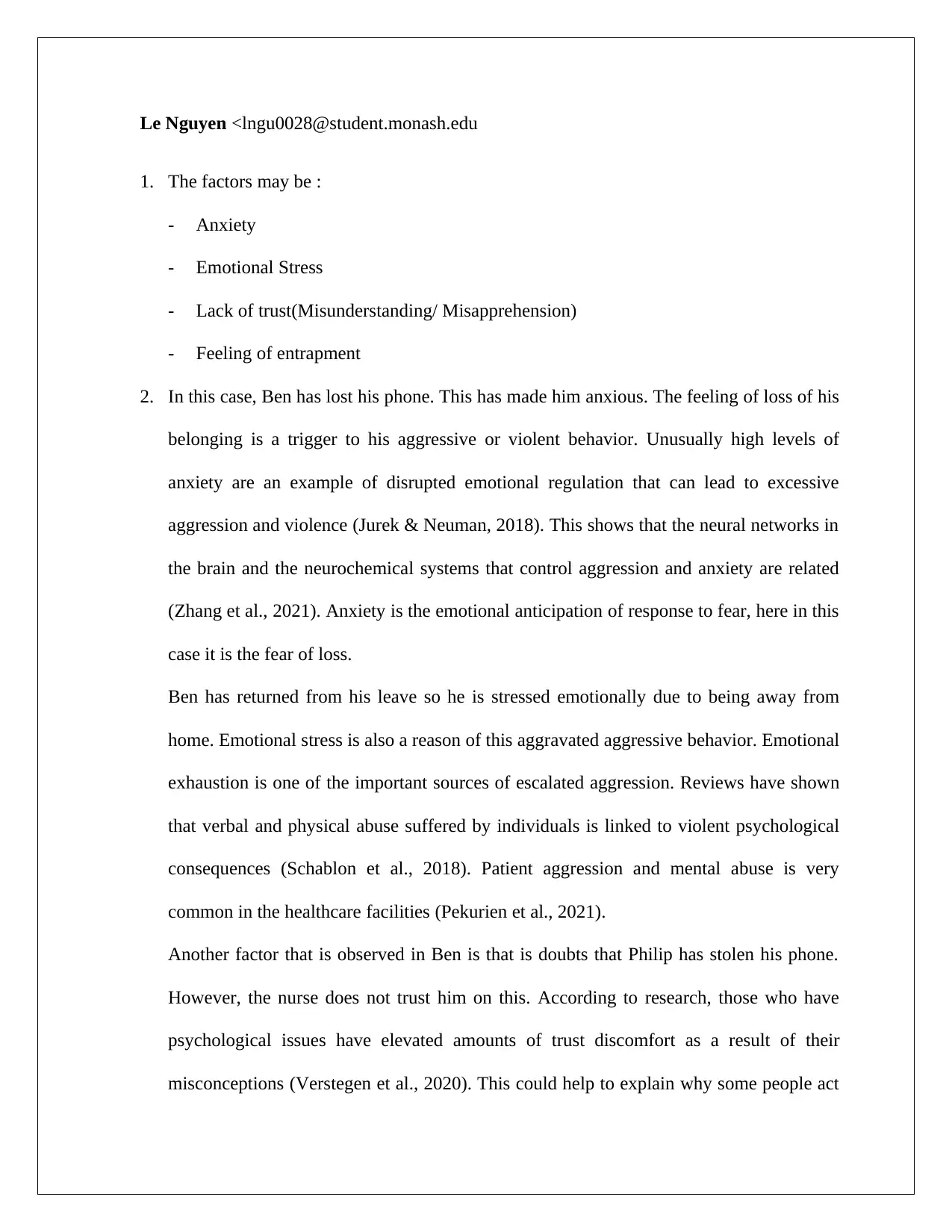
Le Nguyen <lngu0028@student.monash.edu
1. The factors may be :
- Anxiety
- Emotional Stress
- Lack of trust(Misunderstanding/ Misapprehension)
- Feeling of entrapment
2. In this case, Ben has lost his phone. This has made him anxious. The feeling of loss of his
belonging is a trigger to his aggressive or violent behavior. Unusually high levels of
anxiety are an example of disrupted emotional regulation that can lead to excessive
aggression and violence (Jurek & Neuman, 2018). This shows that the neural networks in
the brain and the neurochemical systems that control aggression and anxiety are related
(Zhang et al., 2021). Anxiety is the emotional anticipation of response to fear, here in this
case it is the fear of loss.
Ben has returned from his leave so he is stressed emotionally due to being away from
home. Emotional stress is also a reason of this aggravated aggressive behavior. Emotional
exhaustion is one of the important sources of escalated aggression. Reviews have shown
that verbal and physical abuse suffered by individuals is linked to violent psychological
consequences (Schablon et al., 2018). Patient aggression and mental abuse is very
common in the healthcare facilities (Pekurien et al., 2021).
Another factor that is observed in Ben is that is doubts that Philip has stolen his phone.
However, the nurse does not trust him on this. According to research, those who have
psychological issues have elevated amounts of trust discomfort as a result of their
misconceptions (Verstegen et al., 2020). This could help to explain why some people act
1. The factors may be :
- Anxiety
- Emotional Stress
- Lack of trust(Misunderstanding/ Misapprehension)
- Feeling of entrapment
2. In this case, Ben has lost his phone. This has made him anxious. The feeling of loss of his
belonging is a trigger to his aggressive or violent behavior. Unusually high levels of
anxiety are an example of disrupted emotional regulation that can lead to excessive
aggression and violence (Jurek & Neuman, 2018). This shows that the neural networks in
the brain and the neurochemical systems that control aggression and anxiety are related
(Zhang et al., 2021). Anxiety is the emotional anticipation of response to fear, here in this
case it is the fear of loss.
Ben has returned from his leave so he is stressed emotionally due to being away from
home. Emotional stress is also a reason of this aggravated aggressive behavior. Emotional
exhaustion is one of the important sources of escalated aggression. Reviews have shown
that verbal and physical abuse suffered by individuals is linked to violent psychological
consequences (Schablon et al., 2018). Patient aggression and mental abuse is very
common in the healthcare facilities (Pekurien et al., 2021).
Another factor that is observed in Ben is that is doubts that Philip has stolen his phone.
However, the nurse does not trust him on this. According to research, those who have
psychological issues have elevated amounts of trust discomfort as a result of their
misconceptions (Verstegen et al., 2020). This could help to explain why some people act
Paraphrase This Document
Need a fresh take? Get an instant paraphrase of this document with our AI Paraphraser
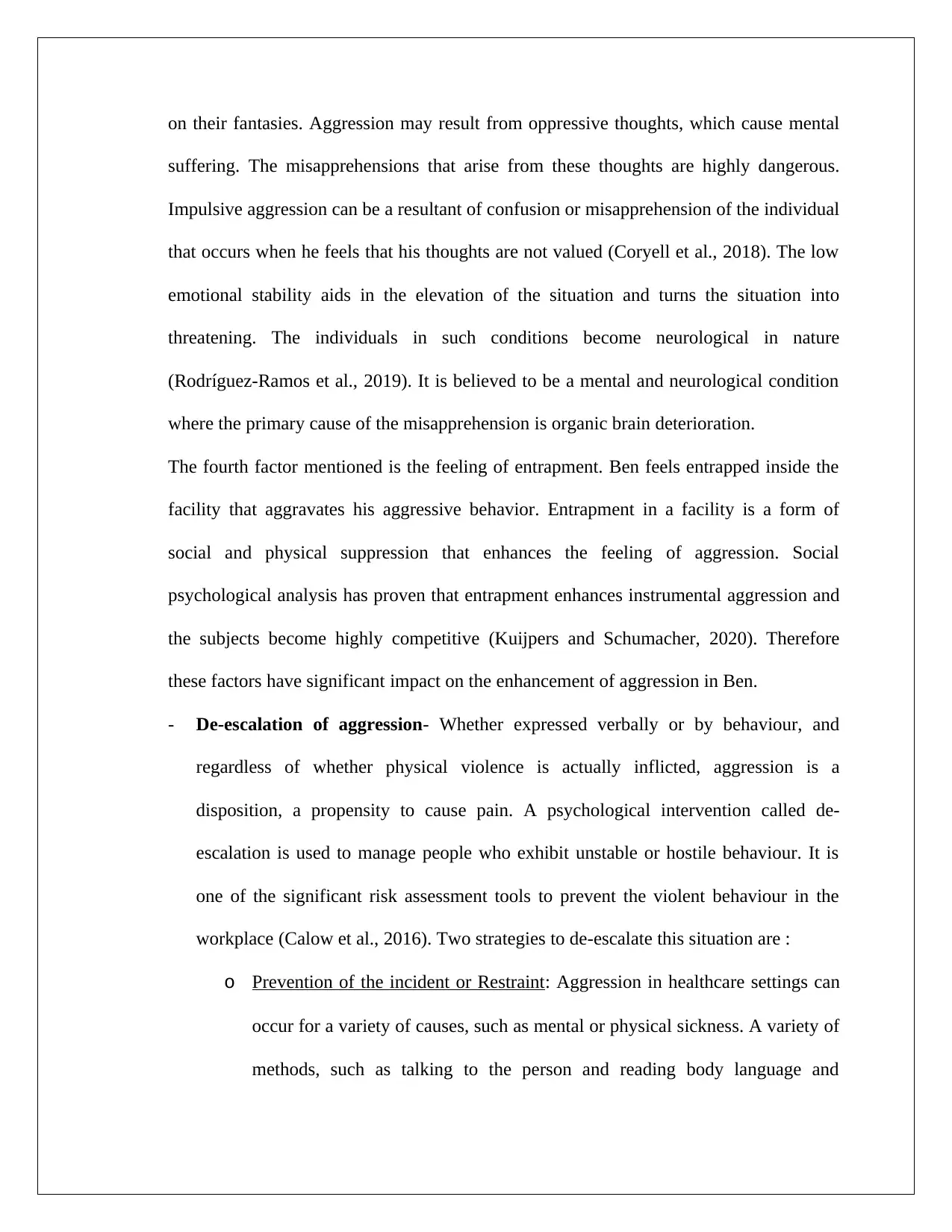
on their fantasies. Aggression may result from oppressive thoughts, which cause mental
suffering. The misapprehensions that arise from these thoughts are highly dangerous.
Impulsive aggression can be a resultant of confusion or misapprehension of the individual
that occurs when he feels that his thoughts are not valued (Coryell et al., 2018). The low
emotional stability aids in the elevation of the situation and turns the situation into
threatening. The individuals in such conditions become neurological in nature
(Rodríguez‐Ramos et al., 2019). It is believed to be a mental and neurological condition
where the primary cause of the misapprehension is organic brain deterioration.
The fourth factor mentioned is the feeling of entrapment. Ben feels entrapped inside the
facility that aggravates his aggressive behavior. Entrapment in a facility is a form of
social and physical suppression that enhances the feeling of aggression. Social
psychological analysis has proven that entrapment enhances instrumental aggression and
the subjects become highly competitive (Kuijpers and Schumacher, 2020). Therefore
these factors have significant impact on the enhancement of aggression in Ben.
- De-escalation of aggression- Whether expressed verbally or by behaviour, and
regardless of whether physical violence is actually inflicted, aggression is a
disposition, a propensity to cause pain. A psychological intervention called de-
escalation is used to manage people who exhibit unstable or hostile behaviour. It is
one of the significant risk assessment tools to prevent the violent behaviour in the
workplace (Calow et al., 2016). Two strategies to de-escalate this situation are :
o Prevention of the incident or Restraint: Aggression in healthcare settings can
occur for a variety of causes, such as mental or physical sickness. A variety of
methods, such as talking to the person and reading body language and
suffering. The misapprehensions that arise from these thoughts are highly dangerous.
Impulsive aggression can be a resultant of confusion or misapprehension of the individual
that occurs when he feels that his thoughts are not valued (Coryell et al., 2018). The low
emotional stability aids in the elevation of the situation and turns the situation into
threatening. The individuals in such conditions become neurological in nature
(Rodríguez‐Ramos et al., 2019). It is believed to be a mental and neurological condition
where the primary cause of the misapprehension is organic brain deterioration.
The fourth factor mentioned is the feeling of entrapment. Ben feels entrapped inside the
facility that aggravates his aggressive behavior. Entrapment in a facility is a form of
social and physical suppression that enhances the feeling of aggression. Social
psychological analysis has proven that entrapment enhances instrumental aggression and
the subjects become highly competitive (Kuijpers and Schumacher, 2020). Therefore
these factors have significant impact on the enhancement of aggression in Ben.
- De-escalation of aggression- Whether expressed verbally or by behaviour, and
regardless of whether physical violence is actually inflicted, aggression is a
disposition, a propensity to cause pain. A psychological intervention called de-
escalation is used to manage people who exhibit unstable or hostile behaviour. It is
one of the significant risk assessment tools to prevent the violent behaviour in the
workplace (Calow et al., 2016). Two strategies to de-escalate this situation are :
o Prevention of the incident or Restraint: Aggression in healthcare settings can
occur for a variety of causes, such as mental or physical sickness. A variety of
methods, such as talking to the person and reading body language and
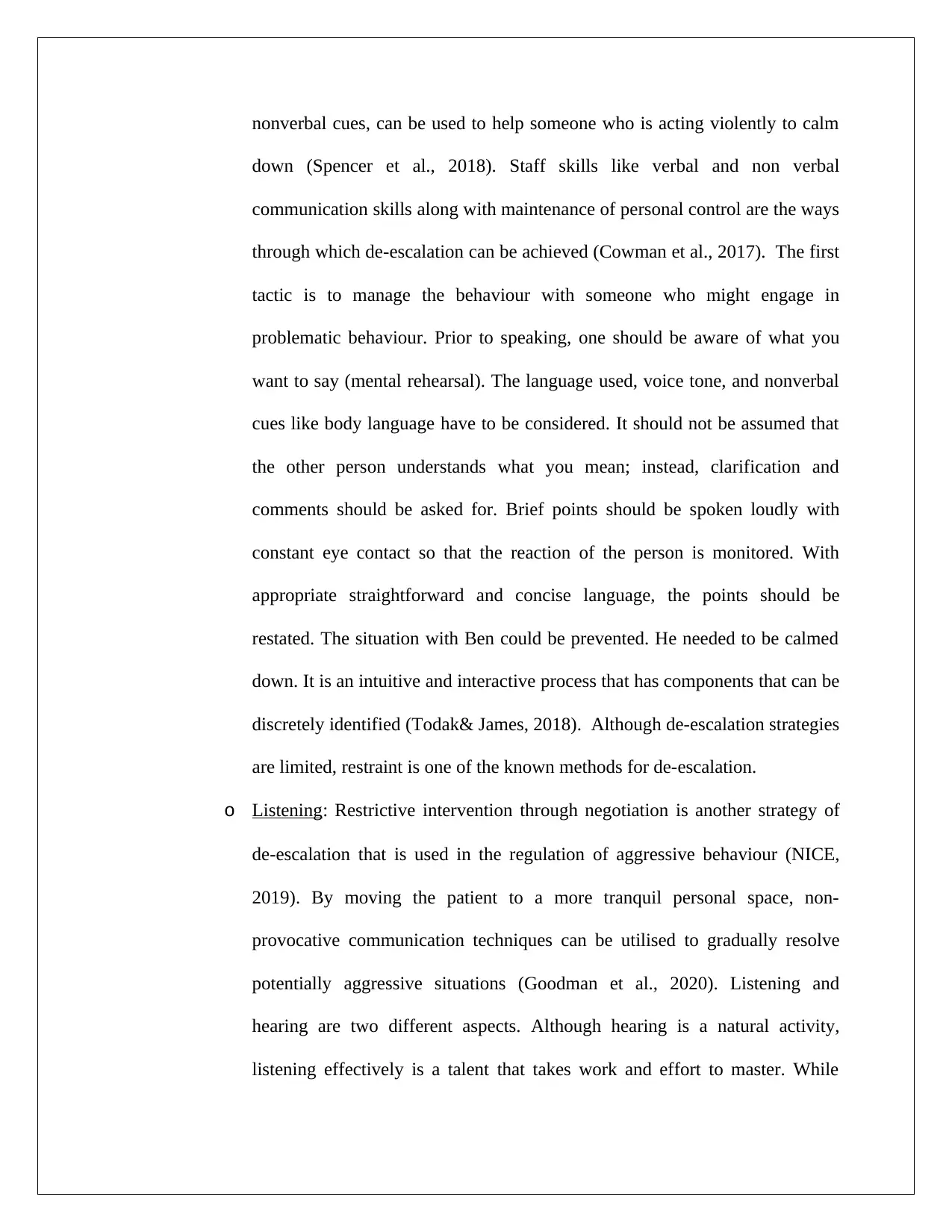
nonverbal cues, can be used to help someone who is acting violently to calm
down (Spencer et al., 2018). Staff skills like verbal and non verbal
communication skills along with maintenance of personal control are the ways
through which de-escalation can be achieved (Cowman et al., 2017). The first
tactic is to manage the behaviour with someone who might engage in
problematic behaviour. Prior to speaking, one should be aware of what you
want to say (mental rehearsal). The language used, voice tone, and nonverbal
cues like body language have to be considered. It should not be assumed that
the other person understands what you mean; instead, clarification and
comments should be asked for. Brief points should be spoken loudly with
constant eye contact so that the reaction of the person is monitored. With
appropriate straightforward and concise language, the points should be
restated. The situation with Ben could be prevented. He needed to be calmed
down. It is an intuitive and interactive process that has components that can be
discretely identified (Todak& James, 2018). Although de-escalation strategies
are limited, restraint is one of the known methods for de-escalation.
o Listening: Restrictive intervention through negotiation is another strategy of
de-escalation that is used in the regulation of aggressive behaviour (NICE,
2019). By moving the patient to a more tranquil personal space, non-
provocative communication techniques can be utilised to gradually resolve
potentially aggressive situations (Goodman et al., 2020). Listening and
hearing are two different aspects. Although hearing is a natural activity,
listening effectively is a talent that takes work and effort to master. While
down (Spencer et al., 2018). Staff skills like verbal and non verbal
communication skills along with maintenance of personal control are the ways
through which de-escalation can be achieved (Cowman et al., 2017). The first
tactic is to manage the behaviour with someone who might engage in
problematic behaviour. Prior to speaking, one should be aware of what you
want to say (mental rehearsal). The language used, voice tone, and nonverbal
cues like body language have to be considered. It should not be assumed that
the other person understands what you mean; instead, clarification and
comments should be asked for. Brief points should be spoken loudly with
constant eye contact so that the reaction of the person is monitored. With
appropriate straightforward and concise language, the points should be
restated. The situation with Ben could be prevented. He needed to be calmed
down. It is an intuitive and interactive process that has components that can be
discretely identified (Todak& James, 2018). Although de-escalation strategies
are limited, restraint is one of the known methods for de-escalation.
o Listening: Restrictive intervention through negotiation is another strategy of
de-escalation that is used in the regulation of aggressive behaviour (NICE,
2019). By moving the patient to a more tranquil personal space, non-
provocative communication techniques can be utilised to gradually resolve
potentially aggressive situations (Goodman et al., 2020). Listening and
hearing are two different aspects. Although hearing is a natural activity,
listening effectively is a talent that takes work and effort to master. While
⊘ This is a preview!⊘
Do you want full access?
Subscribe today to unlock all pages.

Trusted by 1+ million students worldwide
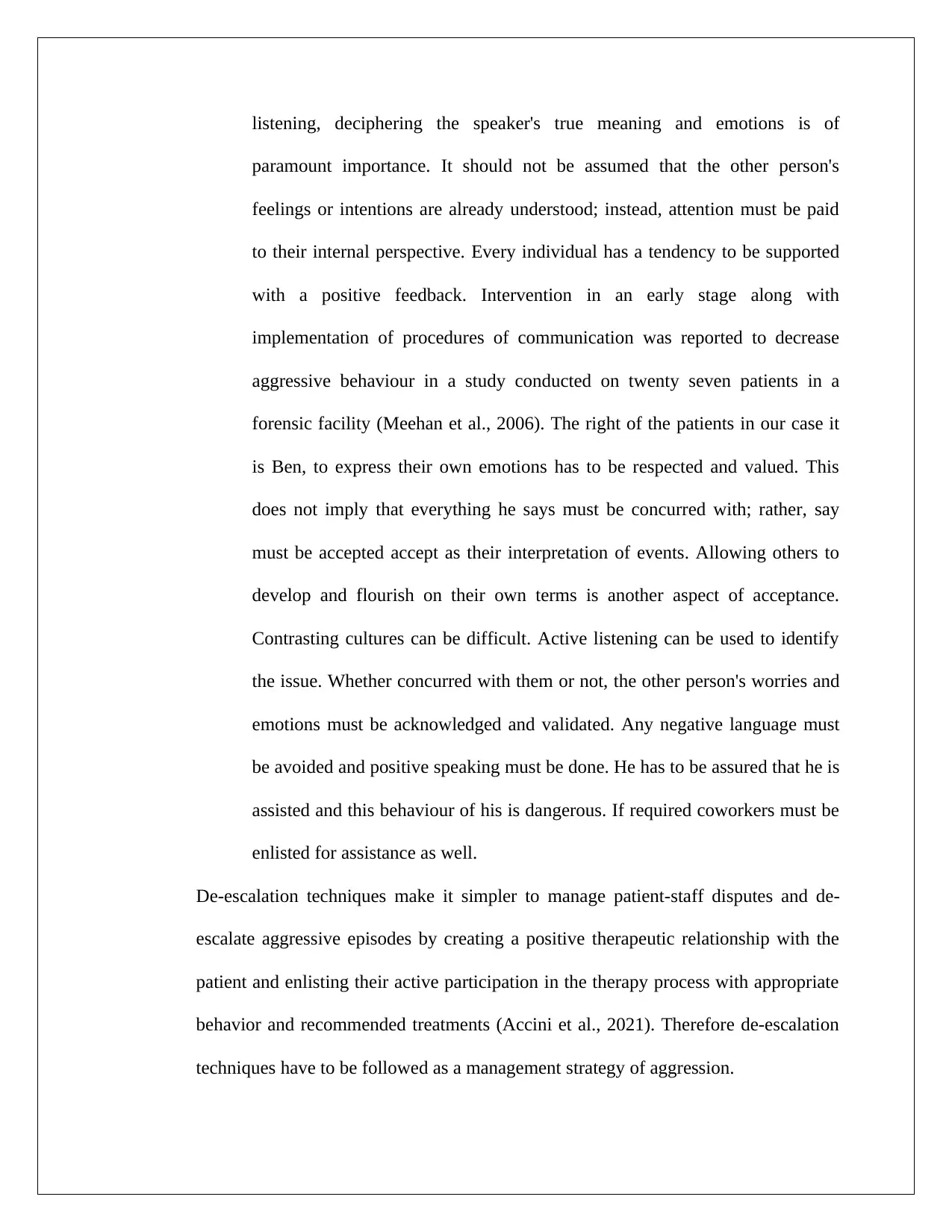
listening, deciphering the speaker's true meaning and emotions is of
paramount importance. It should not be assumed that the other person's
feelings or intentions are already understood; instead, attention must be paid
to their internal perspective. Every individual has a tendency to be supported
with a positive feedback. Intervention in an early stage along with
implementation of procedures of communication was reported to decrease
aggressive behaviour in a study conducted on twenty seven patients in a
forensic facility (Meehan et al., 2006). The right of the patients in our case it
is Ben, to express their own emotions has to be respected and valued. This
does not imply that everything he says must be concurred with; rather, say
must be accepted accept as their interpretation of events. Allowing others to
develop and flourish on their own terms is another aspect of acceptance.
Contrasting cultures can be difficult. Active listening can be used to identify
the issue. Whether concurred with them or not, the other person's worries and
emotions must be acknowledged and validated. Any negative language must
be avoided and positive speaking must be done. He has to be assured that he is
assisted and this behaviour of his is dangerous. If required coworkers must be
enlisted for assistance as well.
De-escalation techniques make it simpler to manage patient-staff disputes and de-
escalate aggressive episodes by creating a positive therapeutic relationship with the
patient and enlisting their active participation in the therapy process with appropriate
behavior and recommended treatments (Accini et al., 2021). Therefore de-escalation
techniques have to be followed as a management strategy of aggression.
paramount importance. It should not be assumed that the other person's
feelings or intentions are already understood; instead, attention must be paid
to their internal perspective. Every individual has a tendency to be supported
with a positive feedback. Intervention in an early stage along with
implementation of procedures of communication was reported to decrease
aggressive behaviour in a study conducted on twenty seven patients in a
forensic facility (Meehan et al., 2006). The right of the patients in our case it
is Ben, to express their own emotions has to be respected and valued. This
does not imply that everything he says must be concurred with; rather, say
must be accepted accept as their interpretation of events. Allowing others to
develop and flourish on their own terms is another aspect of acceptance.
Contrasting cultures can be difficult. Active listening can be used to identify
the issue. Whether concurred with them or not, the other person's worries and
emotions must be acknowledged and validated. Any negative language must
be avoided and positive speaking must be done. He has to be assured that he is
assisted and this behaviour of his is dangerous. If required coworkers must be
enlisted for assistance as well.
De-escalation techniques make it simpler to manage patient-staff disputes and de-
escalate aggressive episodes by creating a positive therapeutic relationship with the
patient and enlisting their active participation in the therapy process with appropriate
behavior and recommended treatments (Accini et al., 2021). Therefore de-escalation
techniques have to be followed as a management strategy of aggression.
Paraphrase This Document
Need a fresh take? Get an instant paraphrase of this document with our AI Paraphraser
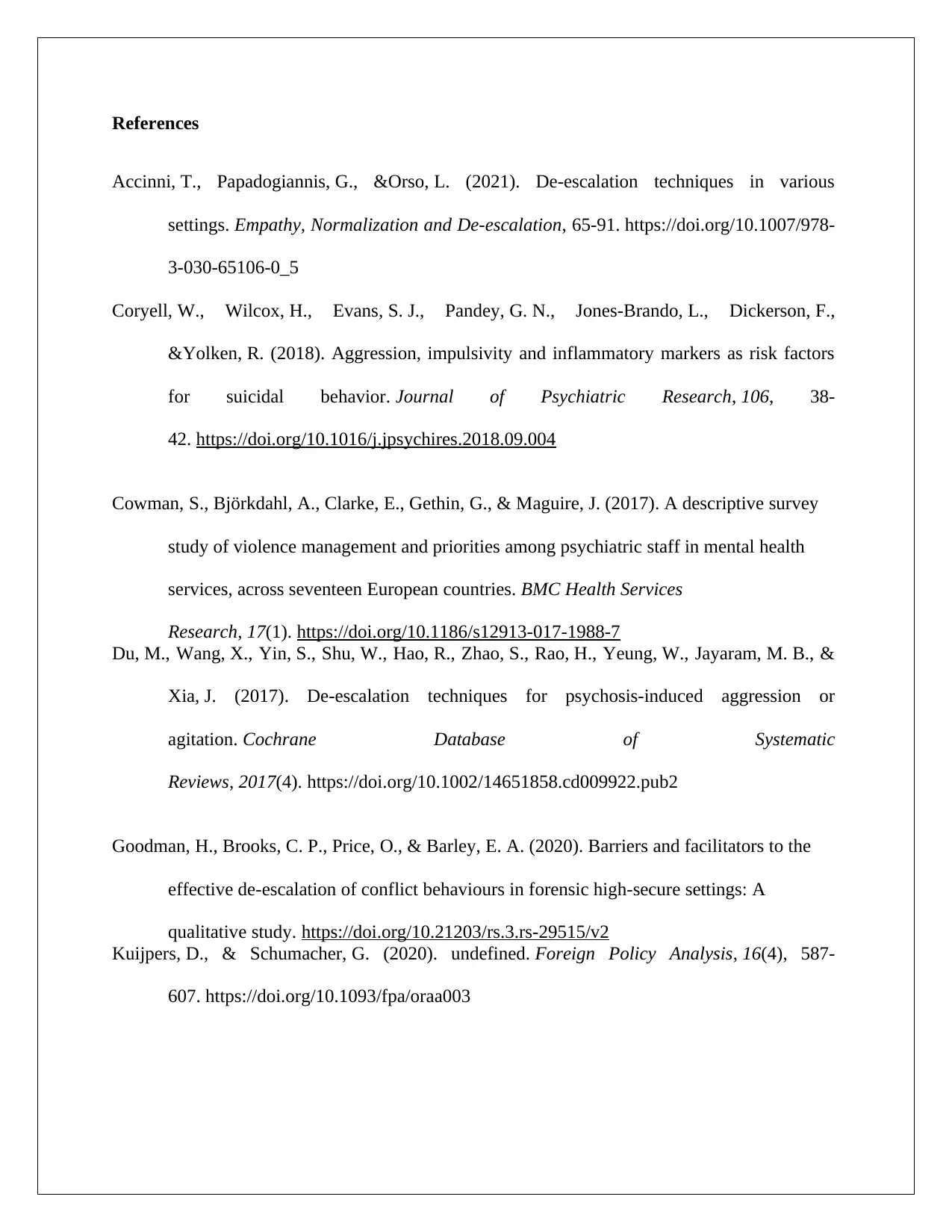
References
Accinni, T., Papadogiannis, G., &Orso, L. (2021). De-escalation techniques in various
settings. Empathy, Normalization and De-escalation, 65-91. https://doi.org/10.1007/978-
3-030-65106-0_5
Coryell, W., Wilcox, H., Evans, S. J., Pandey, G. N., Jones-Brando, L., Dickerson, F.,
&Yolken, R. (2018). Aggression, impulsivity and inflammatory markers as risk factors
for suicidal behavior. Journal of Psychiatric Research, 106, 38-
42. https://doi.org/10.1016/j.jpsychires.2018.09.004
Cowman, S., Björkdahl, A., Clarke, E., Gethin, G., & Maguire, J. (2017). A descriptive survey
study of violence management and priorities among psychiatric staff in mental health
services, across seventeen European countries. BMC Health Services
Research, 17(1). https://doi.org/10.1186/s12913-017-1988-7
Du, M., Wang, X., Yin, S., Shu, W., Hao, R., Zhao, S., Rao, H., Yeung, W., Jayaram, M. B., &
Xia, J. (2017). De-escalation techniques for psychosis-induced aggression or
agitation. Cochrane Database of Systematic
Reviews, 2017(4). https://doi.org/10.1002/14651858.cd009922.pub2
Goodman, H., Brooks, C. P., Price, O., & Barley, E. A. (2020). Barriers and facilitators to the
effective de-escalation of conflict behaviours in forensic high-secure settings: A
qualitative study. https://doi.org/10.21203/rs.3.rs-29515/v2
Kuijpers, D., & Schumacher, G. (2020). undefined. Foreign Policy Analysis, 16(4), 587-
607. https://doi.org/10.1093/fpa/oraa003
Accinni, T., Papadogiannis, G., &Orso, L. (2021). De-escalation techniques in various
settings. Empathy, Normalization and De-escalation, 65-91. https://doi.org/10.1007/978-
3-030-65106-0_5
Coryell, W., Wilcox, H., Evans, S. J., Pandey, G. N., Jones-Brando, L., Dickerson, F.,
&Yolken, R. (2018). Aggression, impulsivity and inflammatory markers as risk factors
for suicidal behavior. Journal of Psychiatric Research, 106, 38-
42. https://doi.org/10.1016/j.jpsychires.2018.09.004
Cowman, S., Björkdahl, A., Clarke, E., Gethin, G., & Maguire, J. (2017). A descriptive survey
study of violence management and priorities among psychiatric staff in mental health
services, across seventeen European countries. BMC Health Services
Research, 17(1). https://doi.org/10.1186/s12913-017-1988-7
Du, M., Wang, X., Yin, S., Shu, W., Hao, R., Zhao, S., Rao, H., Yeung, W., Jayaram, M. B., &
Xia, J. (2017). De-escalation techniques for psychosis-induced aggression or
agitation. Cochrane Database of Systematic
Reviews, 2017(4). https://doi.org/10.1002/14651858.cd009922.pub2
Goodman, H., Brooks, C. P., Price, O., & Barley, E. A. (2020). Barriers and facilitators to the
effective de-escalation of conflict behaviours in forensic high-secure settings: A
qualitative study. https://doi.org/10.21203/rs.3.rs-29515/v2
Kuijpers, D., & Schumacher, G. (2020). undefined. Foreign Policy Analysis, 16(4), 587-
607. https://doi.org/10.1093/fpa/oraa003
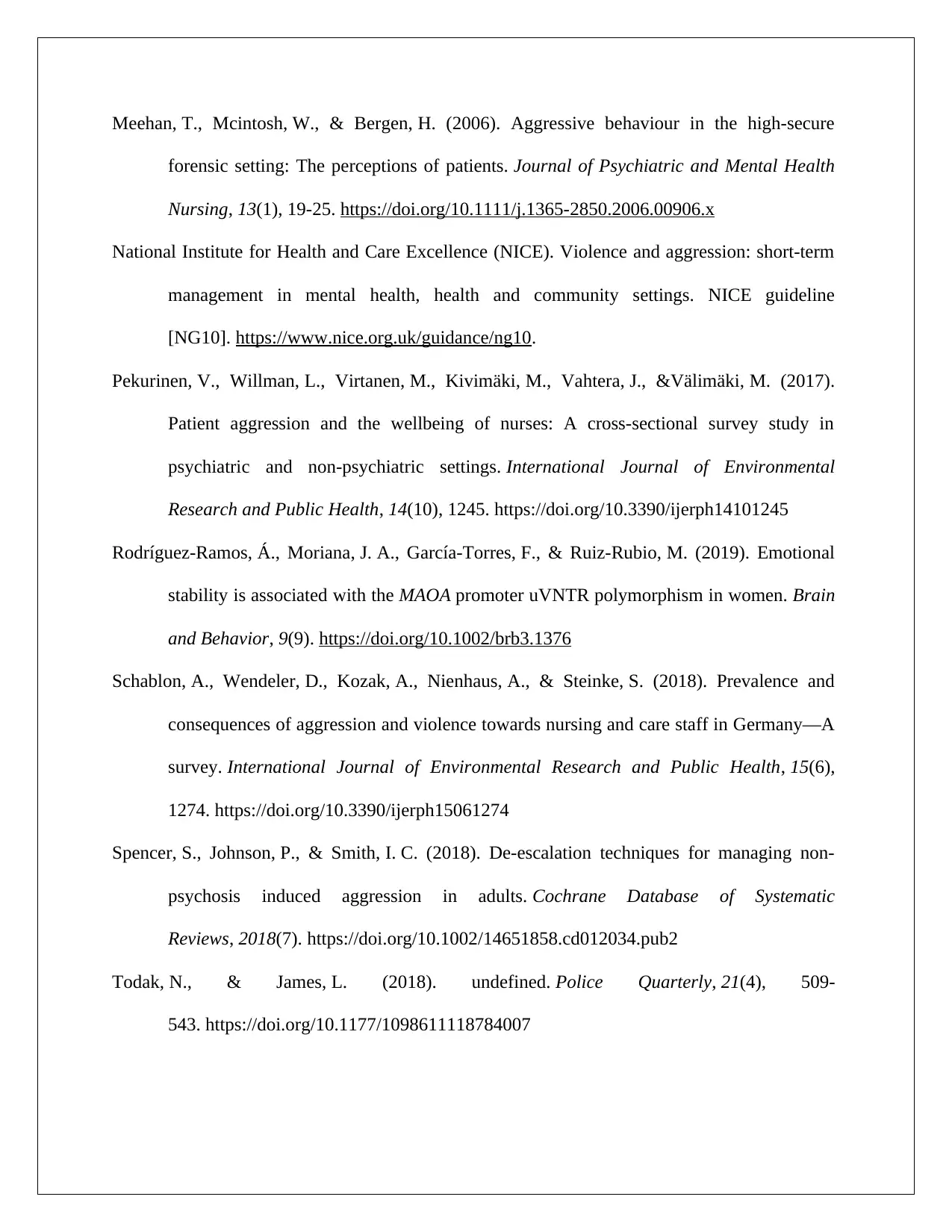
Meehan, T., Mcintosh, W., & Bergen, H. (2006). Aggressive behaviour in the high-secure
forensic setting: The perceptions of patients. Journal of Psychiatric and Mental Health
Nursing, 13(1), 19-25. https://doi.org/10.1111/j.1365-2850.2006.00906.x
National Institute for Health and Care Excellence (NICE). Violence and aggression: short-term
management in mental health, health and community settings. NICE guideline
[NG10]. https://www.nice.org.uk/guidance/ng10.
Pekurinen, V., Willman, L., Virtanen, M., Kivimäki, M., Vahtera, J., &Välimäki, M. (2017).
Patient aggression and the wellbeing of nurses: A cross-sectional survey study in
psychiatric and non-psychiatric settings. International Journal of Environmental
Research and Public Health, 14(10), 1245. https://doi.org/10.3390/ijerph14101245
Rodríguez‐Ramos, Á., Moriana, J. A., García‐Torres, F., & Ruiz‐Rubio, M. (2019). Emotional
stability is associated with the MAOA promoter uVNTR polymorphism in women. Brain
and Behavior, 9(9). https://doi.org/10.1002/brb3.1376
Schablon, A., Wendeler, D., Kozak, A., Nienhaus, A., & Steinke, S. (2018). Prevalence and
consequences of aggression and violence towards nursing and care staff in Germany—A
survey. International Journal of Environmental Research and Public Health, 15(6),
1274. https://doi.org/10.3390/ijerph15061274
Spencer, S., Johnson, P., & Smith, I. C. (2018). De-escalation techniques for managing non-
psychosis induced aggression in adults. Cochrane Database of Systematic
Reviews, 2018(7). https://doi.org/10.1002/14651858.cd012034.pub2
Todak, N., & James, L. (2018). undefined. Police Quarterly, 21(4), 509-
543. https://doi.org/10.1177/1098611118784007
forensic setting: The perceptions of patients. Journal of Psychiatric and Mental Health
Nursing, 13(1), 19-25. https://doi.org/10.1111/j.1365-2850.2006.00906.x
National Institute for Health and Care Excellence (NICE). Violence and aggression: short-term
management in mental health, health and community settings. NICE guideline
[NG10]. https://www.nice.org.uk/guidance/ng10.
Pekurinen, V., Willman, L., Virtanen, M., Kivimäki, M., Vahtera, J., &Välimäki, M. (2017).
Patient aggression and the wellbeing of nurses: A cross-sectional survey study in
psychiatric and non-psychiatric settings. International Journal of Environmental
Research and Public Health, 14(10), 1245. https://doi.org/10.3390/ijerph14101245
Rodríguez‐Ramos, Á., Moriana, J. A., García‐Torres, F., & Ruiz‐Rubio, M. (2019). Emotional
stability is associated with the MAOA promoter uVNTR polymorphism in women. Brain
and Behavior, 9(9). https://doi.org/10.1002/brb3.1376
Schablon, A., Wendeler, D., Kozak, A., Nienhaus, A., & Steinke, S. (2018). Prevalence and
consequences of aggression and violence towards nursing and care staff in Germany—A
survey. International Journal of Environmental Research and Public Health, 15(6),
1274. https://doi.org/10.3390/ijerph15061274
Spencer, S., Johnson, P., & Smith, I. C. (2018). De-escalation techniques for managing non-
psychosis induced aggression in adults. Cochrane Database of Systematic
Reviews, 2018(7). https://doi.org/10.1002/14651858.cd012034.pub2
Todak, N., & James, L. (2018). undefined. Police Quarterly, 21(4), 509-
543. https://doi.org/10.1177/1098611118784007
⊘ This is a preview!⊘
Do you want full access?
Subscribe today to unlock all pages.

Trusted by 1+ million students worldwide
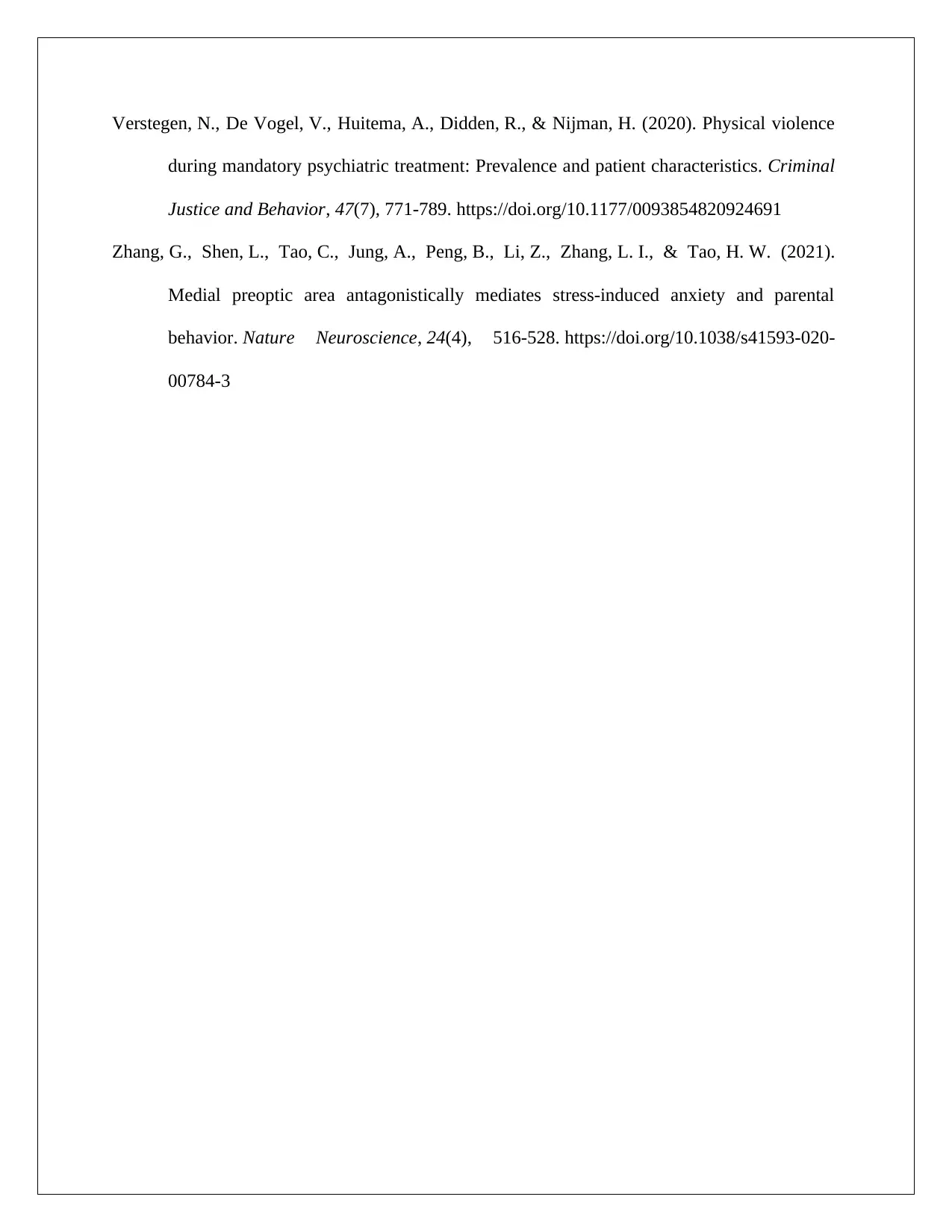
Verstegen, N., De Vogel, V., Huitema, A., Didden, R., & Nijman, H. (2020). Physical violence
during mandatory psychiatric treatment: Prevalence and patient characteristics. Criminal
Justice and Behavior, 47(7), 771-789. https://doi.org/10.1177/0093854820924691
Zhang, G., Shen, L., Tao, C., Jung, A., Peng, B., Li, Z., Zhang, L. I., & Tao, H. W. (2021).
Medial preoptic area antagonistically mediates stress-induced anxiety and parental
behavior. Nature Neuroscience, 24(4), 516-528. https://doi.org/10.1038/s41593-020-
00784-3
during mandatory psychiatric treatment: Prevalence and patient characteristics. Criminal
Justice and Behavior, 47(7), 771-789. https://doi.org/10.1177/0093854820924691
Zhang, G., Shen, L., Tao, C., Jung, A., Peng, B., Li, Z., Zhang, L. I., & Tao, H. W. (2021).
Medial preoptic area antagonistically mediates stress-induced anxiety and parental
behavior. Nature Neuroscience, 24(4), 516-528. https://doi.org/10.1038/s41593-020-
00784-3
1 out of 7
Related Documents
Your All-in-One AI-Powered Toolkit for Academic Success.
+13062052269
info@desklib.com
Available 24*7 on WhatsApp / Email
![[object Object]](/_next/static/media/star-bottom.7253800d.svg)
Unlock your academic potential
Copyright © 2020–2025 A2Z Services. All Rights Reserved. Developed and managed by ZUCOL.





